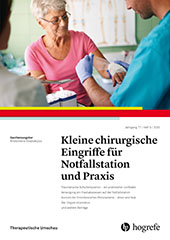Gelenkpunktionen in der Notfallstation
Abstract
Zusammenfassung. Die akute Gelenkschwellung ist ein relativ häufiger Konsultationsgrund auf der Notfallstation. Nach Durchführung der Routineabklärungen (klinische Untersuchung, Labor, evtl. Röntgen), kommt der ätiologischen Klärung der Gelenkschwellung eine bedeutende Rolle zu, wobei besonders die septische Arthritis nicht verpasst werden darf. Entsprechend soll die Indikation zur Gelenkpunktion grosszügig gestellt werden. Während die Punktion bei grösseren und einfach zugänglichen Gelenken (z. B. Knie) landmarkengestützt erfolgen kann, so empfiehlt es sich bei kleineren und / oder schlechter zugänglichen Gelenken (insbesondere Hüfte, Schulter), die Punktion Ultraschall-gestützt durchzuführen. Es hat sich gezeigt, dass im Vergleich zum landmarkengestützten Verfahren die Ultraschall-geführte Punktion schmerzärmer und mit besserem Punktionserfolg durchgeführt werden kann. Laboranalytisch wichtig sind die Bestimmung der Zellzahl inkl. Differenzierung, die Suche nach Kristallen sowie die mikrobiologischen Untersuchungen bestehend aus Gram-Präparat und Kultur. Therapeutisch stehen bei der septischen Arthritis die arthroskopische Spülung und antibiotische Therapie, bei den Kristallarthropathien die lokale Infiltration mit einem Kortikosteroid und / oder die systemische Therapie mit einem nicht-steroidalen Antirheumatikum im Vordergrund. Verschiedene Aspekte der Gelenkpunktion werden in diesem Artikel beleuchtet, inklusive Asepsis, Landmark- und Ultraschall-gestützte Technik der Gelenkpunktion sowie Präanalytik und Interpretation der Punktionsresultate.
Abstract. Acute joint swelling is a common presentation to the emergency department. Although routine investigations like clinical exam, labs and eventually x-ray are usually obtained, definitive diagnosis must be established since timely recognition of septic arthritis in particular is crucial. Definitive diagnosis is achieved by performing an arthrocentesis of the affected joint. While arthrocentesis of larger joints and large effusions (e. g. knee) are relatively easy to perform using the landmark-technique, smaller and less accessible joints (shoulder, elbow, hip) are more difficult to access and it is therefore recommended to use ultrasound guidance. Compared with the landmark-technique, ultrasound-guided arthrocentesis is more successful and less painful. Synovial fluid should be analyzed for cell count with differential, crystals as well as for microbiological analysis such as Gram-stain and culture. Once the diagnosis of septic arthritis has been established, irrigation of the joint should be performed by orthopedic surgery. Antibiotic therapy should be withheld until the sampling of synovial fluid has been completed. After exclusion of septic arthritis, acute arthritis due to crystal arthropathy (CPPD or gout) is treated with either glucocorticoid-infiltration of the joint or with nonsteroidal anti-inflammatory drugs. In this article, the different technical aspects of arthrocentesis are discussed, including asepsis, landmark- and ultrasound-guided access, preanalytics and interpretation of the laboratory results.



